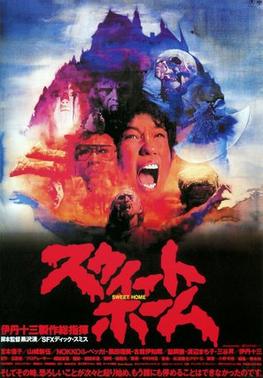 When people discuss the early films of Japan’s Kiyoshi Kurosawa, i.e. those made before his 1997 breakthrough with CURE/KYUA, SWEET HOME (SUIITO HOMU) is invariably one of the key titles mentioned. Made in 1988, when its creator was coming off a pair of indifferently received pinku features (KANDAGAWA WARS/KANSAGAWA INRAN SENSO and THE EXCITEMENT OF THE DO-RE-MI-FA GIRL/DO-RE-MI-FA MUSUME NO CHI WA SAWAGU), it’s a haunted house movie that, like all of Kurosawa’s early work, was made for the “V-Cinema” sphere (i.e. the late eighties Japanese video market). It woefully lacks the complexity and craftsmanship of Kurosawa’s later films, settling instead for a slavish imitation of Hollywood genre tropes.
When people discuss the early films of Japan’s Kiyoshi Kurosawa, i.e. those made before his 1997 breakthrough with CURE/KYUA, SWEET HOME (SUIITO HOMU) is invariably one of the key titles mentioned. Made in 1988, when its creator was coming off a pair of indifferently received pinku features (KANDAGAWA WARS/KANSAGAWA INRAN SENSO and THE EXCITEMENT OF THE DO-RE-MI-FA GIRL/DO-RE-MI-FA MUSUME NO CHI WA SAWAGU), it’s a haunted house movie that, like all of Kurosawa’s early work, was made for the “V-Cinema” sphere (i.e. the late eighties Japanese video market). It woefully lacks the complexity and craftsmanship of Kurosawa’s later films, settling instead for a slavish imitation of Hollywood genre tropes.
Mamiya Mansion, once the home of the painter Ichirou Mamiya, is an allegedly cursed establishment that’s been off limits to the public for 30 years. The TV producer Kazuo is working on a documentary about Mamiya, and manages to wrangle the keys to the mansion from its current none-too-scrupulous overseers. Thus equipped, Kazuo, together with his crewmembers Akiko and Asuka, precocious teenage daughter Emi and nerdy cameraman Taguchi, heads out to the place for an overnight visit.
The crew attempts to settle in to the mansion, which is marked by extravagant avant-garde architecture, but weirdness becomes apparent almost immediately. Murals mysteriously appear on the walls, slide projectors melt and Asuka, caught up in some kind of mental fugue, digs up an infant’s partially decayed corpse in a nearby clearing and then, upset by what she’s done, severely injures herself in a car accident.
It seems that by digging in the clearing Asuka undid the magical strictures keeping a curse in place. As explained by the local transient Yamamura (played by the film’s producer Jûzô Itami), this curse was put in place by the late Lady Mamiya, who murdered infants in an effort to find a playmate for her incinerated child before ending her own life in a similar manner.
Shadowy critters invade the mansion, during which two principal characters die horribly and the proceedings devolve into a POLTERGEIST-like special effects blowout packed with melting flesh, mutations, vast conflagrations, interdimensional passageways and, of course, Lady Mamiya’s unquiet spirit.
The POLTERGEIST comparison is apt, as Steven Spielberg was the film’s most evident influence, with shots lifted rather shamelessly from RAIDERS OF THE LOST ARK and CLOSE ENCOUNTERS OF THE THIRD KIND. The elaborate special effects, meanwhile, were designed by America’s late Dick Smith (1922-2014), the genius behind THE EXORCIST and ALTERED STATES, and are accomplished enough to distract (at times) from the cheap and artificial-looking production design.
In Kurosawa’s defense, his control was far from absolute. The film’s late co-star and producer Jûzô Itami (1933-1997), who at the time of SWEET HOME’s production also happened to be the most successful director in Japan (with THE FUNERAL, TAMPOPO, A TAXING WOMAN and A TAXING WOMAN’S RETURN to his credit), had the final say in what ended up onscreen, and, according to Kurosawa, was unafraid of wielding that power to the fullest.
Yet Kurosawa’s quirky sensibilities aren’t entirely subsumed. The notably up-tempo music score is a delightfully incongruous element, and the film contains some genuinely chilling scenes of atmospheric horror, as when Emi finds herself menaced in a shadowy corridor by an unseen presence—a scene rendered all the more impressive for taking place in near-total silence, a stark reversal of an otherwise pell-mell, noise-happy aesthetic.
Vital Statistics
SWEET HOME
Itami Productions
Director: Kiyoshi Kurosawa
Producer: Jûzô Itami
Screenplay: Kiyoshi Kurosawa
Cast: Nobuko Miyamoto, Shingo Yamashiro, Ichiro Furutachi, Fukumi Kuroda, Nokko, Jûzô Itami, Tsutomu Yamazaki
